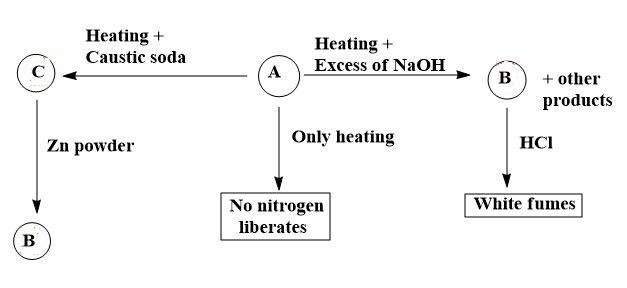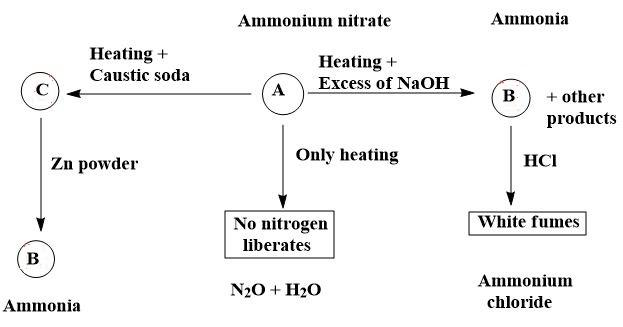
White fumes are:

(A) Chlorine
(B) Hydrogen sulphide
(C) Ammonium chloride
(D) Ammonium hydroxide

Answer
430.5k+ views
Hint: Knowing the compound at the place of ‘A’ can help us solve the given equations easily and thus, find the answer.
As, we need to find only the composition of white fumes, we can solve only one side of the given equation. But for better understanding we should simplify each side of the reaction given (as finding ‘B’ would be simpler from the other path as $A\to C\to B$ )
Complete answer:
Let us move towards the given sample of equation to simplify it and find the required answer.
By analysing and having basic knowledge, let us say that the compound ‘A’ is ammonium nitrate i.e. $N{{H}_{4}}N{{O}_{3}}$ . Now, by moving step by step;
1. On thermal decomposition i.e. heating ammonium nitrate, it gives a mixture of ${{N}_{2}}O+{{H}_{2}}O$ as,
$N{{H}_{4}}N{{O}_{3}}\to {{N}_{2}}O+2{{H}_{2}}O$
2. On heating ammonium nitrate with caustic soda, it gives a mixture of $NaN{{O}_{3}}+N{{H}_{3}}+{{H}_{2}}O$ as,
$N{{H}_{4}}N{{O}_{3}}+NaOH\to NaN{{O}_{3}}+N{{H}_{3}}+{{H}_{2}}O$
Then the mixture of $NaN{{O}_{3}}+N{{H}_{3}}+{{H}_{2}}O$ on reduction with Zn powder gives a gas which is a replacement of ‘B’ i.e. ammonia gas.
3. On heating ammonium nitrate with excess NaOH, it gives ‘B’ i.e. ammonia gas along with other products. When the ammonia gas produced reacts with HCl, it forms white fumes of ammonium chloride as,
$N{{H}_{3}}+HCl\to N{{H}_{4}}Cl$
Thus, we can say that,
A – ammonium nitrate
B – ammonia gas
White fumes produced – ammonium chloride
All this can be shown by a sample equation as,

Therefore, option (C) is correct.
Note:
Do note to analyse each and every step to have a brief understanding of the whole equation and thus the reaction taking place.
As, we need to find only the composition of white fumes, we can solve only one side of the given equation. But for better understanding we should simplify each side of the reaction given (as finding ‘B’ would be simpler from the other path as $A\to C\to B$ )
Complete answer:
Let us move towards the given sample of equation to simplify it and find the required answer.
By analysing and having basic knowledge, let us say that the compound ‘A’ is ammonium nitrate i.e. $N{{H}_{4}}N{{O}_{3}}$ . Now, by moving step by step;
1. On thermal decomposition i.e. heating ammonium nitrate, it gives a mixture of ${{N}_{2}}O+{{H}_{2}}O$ as,
$N{{H}_{4}}N{{O}_{3}}\to {{N}_{2}}O+2{{H}_{2}}O$
2. On heating ammonium nitrate with caustic soda, it gives a mixture of $NaN{{O}_{3}}+N{{H}_{3}}+{{H}_{2}}O$ as,
$N{{H}_{4}}N{{O}_{3}}+NaOH\to NaN{{O}_{3}}+N{{H}_{3}}+{{H}_{2}}O$
Then the mixture of $NaN{{O}_{3}}+N{{H}_{3}}+{{H}_{2}}O$ on reduction with Zn powder gives a gas which is a replacement of ‘B’ i.e. ammonia gas.
3. On heating ammonium nitrate with excess NaOH, it gives ‘B’ i.e. ammonia gas along with other products. When the ammonia gas produced reacts with HCl, it forms white fumes of ammonium chloride as,
$N{{H}_{3}}+HCl\to N{{H}_{4}}Cl$
Thus, we can say that,
A – ammonium nitrate
B – ammonia gas
White fumes produced – ammonium chloride
All this can be shown by a sample equation as,

Therefore, option (C) is correct.
Note:
Do note to analyse each and every step to have a brief understanding of the whole equation and thus the reaction taking place.
Recently Updated Pages
Can anyone list 10 advantages and disadvantages of friction

What are the Components of Financial System?

How do you arrange NH4 + BF3 H2O C2H2 in increasing class 11 chemistry CBSE

Is H mCT and q mCT the same thing If so which is more class 11 chemistry CBSE

What are the possible quantum number for the last outermost class 11 chemistry CBSE

Is C2 paramagnetic or diamagnetic class 11 chemistry CBSE

Trending doubts
The correct order of melting point of 14th group elements class 11 chemistry CBSE

One Metric ton is equal to kg A 10000 B 1000 C 100 class 11 physics CBSE

What is the specific heat capacity of ice water and class 11 physics CBSE

State the laws of reflection of light

Proton was discovered by A Thomson B Rutherford C Chadwick class 11 chemistry CBSE

Why does niobium have a d4s1 electron configuration class 11 chemistry CBSE




